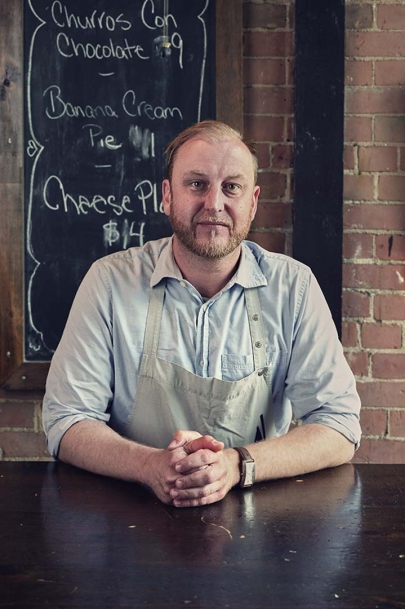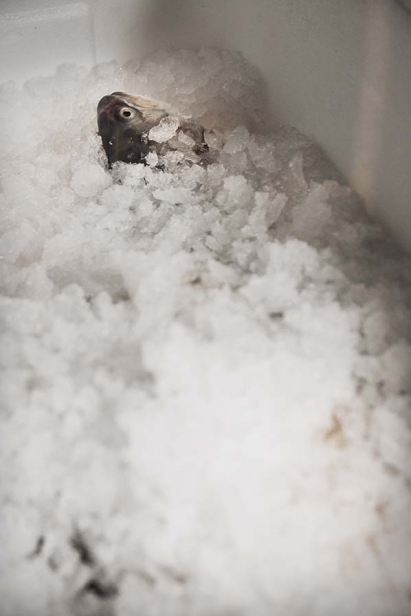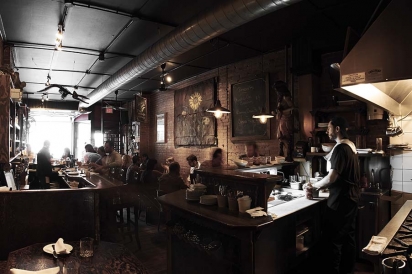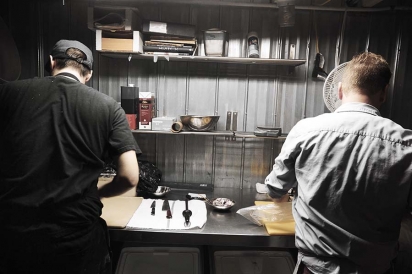Working for Food: Michael Radford, The Whalesbone
There is a place behind the line, found in any cramped, high intensity kitchen called the Dragon’s Breath. It is a position that has you pinned between the pass, the ovens and burners that are releasing a relentless wave of heat at your backside. Fryers and hot pans sputter hot fumes and oils while blinding heat lamps slowly roast your arms and hands as you frantically plate the ceaseless orders screaming in from the chit printer. Compressors from the fridges below spew hot exhaust, keeping the entire whirling ball of scorching air circulating around you as you work through another intense service.
If that’s not enough to dissuade you from perpetual long hours and physical exhaustion then perhaps the endless lacerations, burns, welts and blisters will. You will soon amass a collection of gruesome scars, a visual record of your incessant injuries with large knives and open flames. If you happen to find yourself in a kitchen of merit, there will be constant pressure not only to produce hundreds upon hundreds of plates of food daily, but also to ensure that every one is innovative, interesting and orchestrated to perfection. If not, you will hear about it. The whole world will hear about it.
Oh, and there is very, very little money to be made.
This is the life of a chef. Michael Radford’s parents had hoped that this reality would be enough to deter him. “They thought I was crazy for getting involved in this industry. My dad kept on saying, ‘What? You make how much an hour?”
In his first year as executive chef of the Whalesbone Oyster Houses and Fish Supply Restaurants in Ottawa, after three years at the helm of its flagship restaurant at 430 Bank St., Radford works in one of the smallest kitchens in Ottawa, in perhaps the most excruciating Dragon’s Breath in the entire city. It is not where he, or his parents, expected he would end up. “I had come to Ottawa to study science. In no way did I intend on getting into culinary.”
Radford had always been drawn to marine sciences, a far cry from the sweltering heat of the kitchen. It was a natural choice for a kid raised so close to the oceans. His family had moved from their home in Toronto when Radford was 10, after his father was offered a job in Vancouver. He spent the next three years in the wake of the mighty Fraser River, awed by the dramatic lifecycle of its most iconic inhabitant. “I was hiking with my dad, watching the salmon fly up the river to spawn and then die. The bears would come out to eat them,” he reminisces.
His grandparents had been living in B.C on the eastern shore of Vancouver Island. His grandfather was a fly-fisherman and Radford shared a similar fondness for casting a line. The changes in the salmon from year to year had a profound effect on young Radford, with some years running a glut and the next, zip. “It was the '80s and being out West, we were aware of things. My parents taught me to consider everything that was living and everything that is important to sustain our future.”
Just before Radford’s 13th birthday, his parents were discussing another job transfer over an issue of National Geographic, a feature of Barbados on its cover. “I came downstairs for breakfast and my mom announces “Guess where we’re moving?’” Radford soon came face to face with the precarious culture of life on a small Caribbean island. “That opened up my eyes even more. It was like a third-world perspective. We were going down to the beach when the fishermen were coming in and buying the fish directly from them. It all really stuck with me.”
In hopes of securing their son’s future, Radford’s parents sent him back to Canada to wrap up his final year at a boarding school in Port Hope, Ontario. Being a bright kid armed with good grades, Radford had his choice of universities. In the end, he followed one of his good friends to Carleton University in Ottawa to study marine biology. “In hindsight, I probably should have gone to the ocean — to Dalhousie.”
By his second year of school, Radford was feeling the fiscal pinch. He found a job as a dishwasher and spent the next seven years working at the busy Bravo Bravo Bar and Ristorante on Elgin Street. “I started from the bottom. I started doing prep and kind of had this realization that I enjoyed what I was doing. By the time I left, I was basically running the kitchen.”
In the meantime, he had grown disenchanted with his biology degree. Radford had discovered he had a knack for cooking, especially with fish. One of the servers, sensing his potential, introduced him to Matthew Carmichael, then chef at E18hteen in the ByWard Market. Carmichael hired him immediately and introduced him to an entirely new world of food, one that took Radford well beyond the contents of a Sysco truck.
Still, his parents pressed him. “There were constant fights that were strictly monetary. They said, ‘Well, if you are serious about cooking then you should go to school.’”
Unbeknownst to them, Radford was already entrenched in an intense culinary education founded upon the same sustainable ideals that had drawn him to university in the first place. Carmichael and his mentor, John Taylor, were committed to local and sustainable products and Radford was encouraged to treat his low-wage labour in the kitchen as an opportunity. “I had chefs telling me, “Look, you are working like crazy. You do this and you come in and do what you’re told to do. Buy yourself some books and you will learn.”
When the head chef job came up at Savana Café (now closed), Carmichael personally phoned the owner, Cathy Dewar, and told her that Radford was her man. “He told me I needed to go and told her that I deserved my own kitchen.”
Radford was immediately suited to the bustling Caribbean-styled café. It was there that he met the likes of Mitch Fowler, then a cook at Savana, and Ian Walker of Mariposa Farm. Under Walker’s encouragement, Radford took his team to Mariposa to plant a garden. Now, not only was he cooking food for hundreds of guests a week, he was growing it too. “I was going out there every week and cutting and trying to figure out what the heck I was going to do with all of this stuff that was coming out of the ground!”
By the time Savana closed in 2011, Radford had met Charlotte Langley, then head chef of the Whalesbone Oyster House and she easily persuaded him into the intensity of its quixotic kitchen. The Whalesbone had been pivotal in shifting the culinary landscape of Ottawa’s food scene, enticing an increasingly aware dining demographic with responsible fish and seafood and their signature brand of raucous maritime hospitality. It was the perfect fit for an accidental chef with a fierce loyalty to sustainable culture, a distinct affinity for fish and the perplexing addiction to hard, physical labour shared by many chefs in the city.
Late on a Wednesday in mid-June, Radford is still working. He has been at it since 8am, spending most of his day at the Elmdale Tavern and Oyster House, fine-tuning the launch of the new menu at the Whalesbone’s latest venture and hustling back to Centretown to pump out a busy dinner service, deep in the beast’s hot breath. Twenty years after his fateful arrival in Ottawa, Radford is not only one of the hardest-working chefs in the city, but a busy merchant, leading the charge of the entire sustainable seafood fleet, and encouraging responsible consumption of marine life across the landlocked city. Through the intensity of it all, he manages to keep a smile on his face and shows no signs of slowing. “Today is one of my longest days,” he freely admits. Radford is quick to shrug it off. He knows that he is exactly where he should be.
“That’s what people need to understand,” Radford says about working for food, “we do this because we love it. We do this to make you happy.” You can’t help but hope that his parents finally understand it, too.









